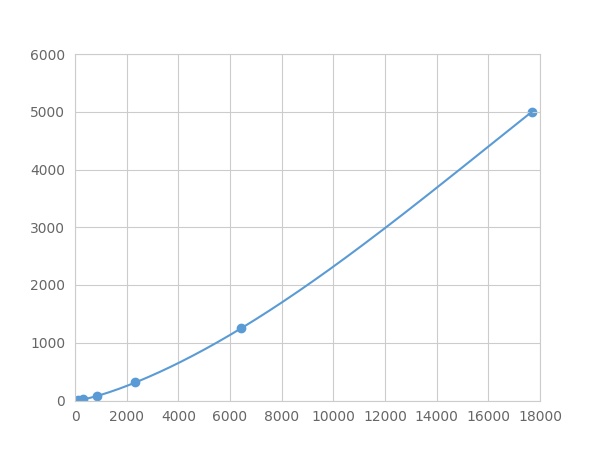Packages (Simulation)

Reagent Preparation

Image (I)
Image (II)
Certificate


Multiplex Assay Kit for Tissue Factor Pathway Inhibitor (TFPI) ,etc. by FLIA (Flow Luminescence Immunoassay)
TFI; EPI; LACI; TFPI1; Lipoprotein-Associated Coagulation Inhibitor; Extrinsic pathway inhibitor
(Note: Up to 8-plex in one testing reaction)
- Product No.LMA394Mu
- Organism SpeciesMus musculus (Mouse) Same name, Different species.
- Sample TypePlasma, urine, cell culture supernates and other biological fluids
- Test MethodDouble-antibody Sandwich
- Assay Length3.5h
- Detection Range4.88-5000pg/mL
- SensitivityThe minimum detectable dose of this kit is typically less than 1.627 pg/mL.
- DownloadInstruction Manual
- UOM 8Plex 7Plex 6Plex 5Plex 4Plex 3Plex 2Plex1Plex
- FOB
US$ 405
US$ 420
US$ 443
US$ 475
US$ 506
US$ 552
US$ 622
US$ 778
Add to Price Calculator
Result
For more details, please contact local distributors!
Specificity
This assay has high sensitivity and excellent specificity for detection of Tissue Factor Pathway Inhibitor (TFPI) ,etc. by FLIA (Flow Luminescence Immunoassay).
No significant cross-reactivity or interference between Tissue Factor Pathway Inhibitor (TFPI) ,etc. by FLIA (Flow Luminescence Immunoassay) and analogues was observed.
Recovery
Matrices listed below were spiked with certain level of recombinant Tissue Factor Pathway Inhibitor (TFPI) ,etc. by FLIA (Flow Luminescence Immunoassay) and the recovery rates were calculated by comparing the measured value to the expected amount of Tissue Factor Pathway Inhibitor (TFPI) ,etc. by FLIA (Flow Luminescence Immunoassay) in samples.
| Matrix | Recovery range (%) | Average(%) |
| EDTA plasma(n=5) | 88-98 | 95 |
| heparin plasma(n=5) | 89-97 | 93 |
Precision
Intra-assay Precision (Precision within an assay): 3 samples with low, middle and high level Tissue Factor Pathway Inhibitor (TFPI) ,etc. by FLIA (Flow Luminescence Immunoassay) were tested 20 times on one plate, respectively.
Inter-assay Precision (Precision between assays): 3 samples with low, middle and high level Tissue Factor Pathway Inhibitor (TFPI) ,etc. by FLIA (Flow Luminescence Immunoassay) were tested on 3 different plates, 8 replicates in each plate.
CV(%) = SD/meanX100
Intra-Assay: CV<10%
Inter-Assay: CV<12%
Linearity
The linearity of the kit was assayed by testing samples spiked with appropriate concentration of Tissue Factor Pathway Inhibitor (TFPI) ,etc. by FLIA (Flow Luminescence Immunoassay) and their serial dilutions. The results were demonstrated by the percentage of calculated concentration to the expected.
| Sample | 1:2 | 1:4 | 1:8 | 1:16 |
| EDTA plasma(n=5) | 78-92% | 84-91% | 86-101% | 90-98% |
| heparin plasma(n=5) | 98-105% | 83-91% | 80-94% | 93-103% |
Stability
The stability of kit is determined by the loss rate of activity. The loss rate of this kit is less than 5% within the expiration date under appropriate storage condition.
To minimize extra influence on the performance, operation procedures and lab conditions, especially room temperature, air humidity, incubator temperature should be strictly controlled. It is also strongly suggested that the whole assay is performed by the same operator from the beginning to the end.
Reagents and materials provided
| Reagents | Quantity | Reagents | Quantity |
| 96-well plate | 1 | Plate sealer for 96 wells | 4 |
| Pre-Mixed Standard | 2 | Standard Diluent | 1×20mL |
| Pre-Mixed Magnetic beads (22#:TFPI) | 1 | Analysis buffer | 1×20mL |
| Pre-Mixed Detection Reagent A | 1×120μL | Assay Diluent A | 1×12mL |
| Detection Reagent B (PE-SA) | 1×120μL | Assay Diluent B | 1×12mL |
| Sheath Fluid | 1×10mL | Wash Buffer (30 × concentrate) | 1×20mL |
| Instruction manual | 1 |
Assay procedure summary
1. Preparation of standards, reagents and samples before the experiment;
2. Add 100μL standard or sample to each well,
add 10μL magnetic beads, and incubate 90min at 37°C on shaker;
3. Remove liquid on magnetic frame, add 100μL prepared Detection Reagent A. Incubate 60min at 37°C on shaker;
4. Wash plate on magnetic frame for three times;
5. Add 100μL prepared Detection Reagent B, and incubate 30 min at 37°C on shaker;
6. Wash plate on magnetic frame for three times;
7. Add 100μL sheath solution, swirl for 2 minutes, read on the machine.
GIVEAWAYS
INCREMENT SERVICES
| Magazine | Citations |
| South African Journal of Child Health | Tissue factor pathway inhibitor in paediatric patients with nephrotic syndrome Sajch: 383 |
| the journal of immunology | Cathepsin G in Experimental Tuberculosis: Relevance for Antibacterial Protection and Potential for Immunotherapy PubMed: 26320257 |
| Molecular Nutrition & Food Research | Trans‐fatty acid promotes thrombus formation in mice by aggravating antithrombogenic endothelial functions via Toll‐like receptors PubMed: 25546502 |
| Molecular Carcinogenesis | Endothelial cell‐anchored tissue factor pathway inhibitor regulates tumor metastasis to the lung in mice PubMed: 25945811 |
| Cell Biology International | Extracellular vesicles from malignant effusions induce tumor cell migration: inhibitory effect ofLMWH tinzaparin. pubmed:27435911 |
| International Journal of Infectious Diseases | Kunitz-type protease inhibitor as a vaccine candidate against schistosomiasis mansoni pubmed:29128645 |





